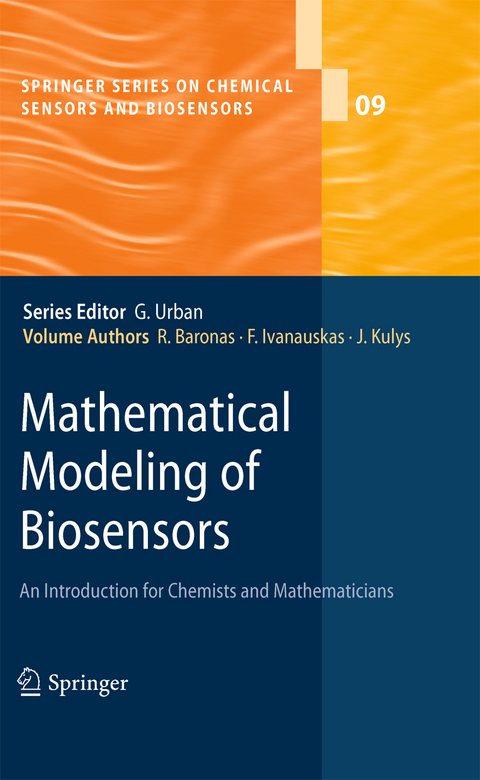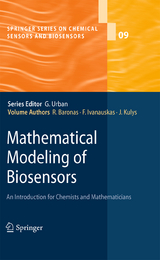Mathematical Modeling of Biosensors
An Introduction for Chemists and Mathematicians
Seiten
2009
|
2010 ed.
Springer (Verlag)
978-90-481-3242-3 (ISBN)
Springer (Verlag)
978-90-481-3242-3 (ISBN)
- Titel erscheint in neuer Auflage
- Artikel merken
Biosensors are analytical devices in which speci?c recognition of the chemical substances is performed by biological material. Historically this method was used to describe fundamental features of biosensors action though it is limited by substrate concentration, and is applicable for simple biocatalytical processes.
Biosensors are analytical devices in which speci?c recognition of the chemical substances is performed by biological material. The biological material that serves as recognition element is used in combination with a transducer. The transducer transforms concentration of substrate or product to electrical signal that is amp- ?ed and further processed. The biosensors may utilize enzymes, antibodies, nucleic acids, organelles, plant and animal tissue, whole organism or organs. Biosensors containing biological catalysts (enzymes) are called catalytical biosensors. These type of biosensors are the most abundant, and they found the largest application in medicine, ecology, and environmental monitoring. The action of catalytical biosensors is associated with substrate diffusion into biocatalytical membrane and it conversion to a product. The modeling of bios- sors involves solving the diffusion equations for substrate and product with a term containing a rate of biocatalytical transformation of substrate. The complications of modeling arise due to solving of partially differential equations with non-linear biocatalytical term and with complex boundary and initial conditions. The book starts with the modeling biosensors by analytical solution of partial differential equations. Historically this method was used to describe fundamental features of biosensors action though it is limited by substrate concentration, and is applicable for simple biocatalytical processes. Using this method the action of biosensors was analyzed at critical concentrations of substrate and enzyme activity.
Biosensors are analytical devices in which speci?c recognition of the chemical substances is performed by biological material. The biological material that serves as recognition element is used in combination with a transducer. The transducer transforms concentration of substrate or product to electrical signal that is amp- ?ed and further processed. The biosensors may utilize enzymes, antibodies, nucleic acids, organelles, plant and animal tissue, whole organism or organs. Biosensors containing biological catalysts (enzymes) are called catalytical biosensors. These type of biosensors are the most abundant, and they found the largest application in medicine, ecology, and environmental monitoring. The action of catalytical biosensors is associated with substrate diffusion into biocatalytical membrane and it conversion to a product. The modeling of bios- sors involves solving the diffusion equations for substrate and product with a term containing a rate of biocatalytical transformation of substrate. The complications of modeling arise due to solving of partially differential equations with non-linear biocatalytical term and with complex boundary and initial conditions. The book starts with the modeling biosensors by analytical solution of partial differential equations. Historically this method was used to describe fundamental features of biosensors action though it is limited by substrate concentration, and is applicable for simple biocatalytical processes. Using this method the action of biosensors was analyzed at critical concentrations of substrate and enzyme activity.
Analytical Modeling of Biosensors.- Biosensor Action.- Modeling Biosensors at Steady State and Internal Diffusion Limitations.- Modeling Biosensors at Steady State and External Diffusion Limitations.- Modeling Biosensors Utilizing Microbial Cells.- Modeling Nonstationary State of Biosensors.- Numerical Modeling of Biosensors.- Mono-Layer Mono-Enzyme Models of Biosensors.- One-Layer Multi-Enzyme Models of Biosensors.- Multi-Layer Models of Biosensors.- Modeling Biosensors of Complex Geometry.- Numerical Methods for Reaction-Diffusion Equations.- The Difference Schemes for the Diffusion Equation.- The Difference Schemes for the Reaction–Diffusion Equations.
| Erscheint lt. Verlag | 1.12.2009 |
|---|---|
| Reihe/Serie | Springer Series on Chemical Sensors and Biosensors ; 9 |
| Zusatzinfo | XIX, 334 p. |
| Verlagsort | Dordrecht |
| Sprache | englisch |
| Maße | 155 x 235 mm |
| Gewicht | 1490 g |
| Themenwelt | Informatik ► Grafik / Design ► Digitale Bildverarbeitung |
| Mathematik / Informatik ► Mathematik ► Analysis | |
| Mathematik / Informatik ► Mathematik ► Angewandte Mathematik | |
| Medizin / Pharmazie ► Physiotherapie / Ergotherapie ► Orthopädie | |
| Naturwissenschaften ► Chemie | |
| Naturwissenschaften ► Physik / Astronomie | |
| Technik ► Medizintechnik | |
| Technik ► Umwelttechnik / Biotechnologie | |
| Schlagworte | Biosensoren |
| ISBN-10 | 90-481-3242-8 / 9048132428 |
| ISBN-13 | 978-90-481-3242-3 / 9789048132423 |
| Zustand | Neuware |
| Haben Sie eine Frage zum Produkt? |
Mehr entdecken
aus dem Bereich
aus dem Bereich
Modelle für 3D-Druck und CNC entwerfen
Buch | Softcover (2022)
dpunkt (Verlag)
CHF 48,85
alles zum Drucken, Scannen, Modellieren
Buch | Softcover (2024)
Markt + Technik Verlag
CHF 34,90




